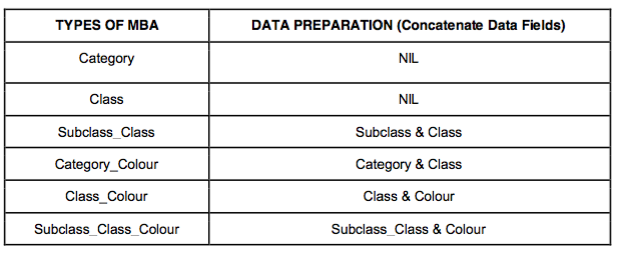Uncovering Market-Insights for Charles & Keith: MBA
| HOME | OVERVIEW | DATA PREPARATION | ANALYSIS | PROJECT MANAGEMENT | DOCUMENTATION |
Due to the confidentiality of the data provided by our sponsor, we would be only showing the methods of analysis without the results. For authorised stakeholders, please refer to our report for more in-depth analysis with charts and descriptions.
Our team’s motivation to mine for association rules was to gain a deeper understanding of customer buying preference. Based on our Exploratory Data Analysis, we discovered that up to x% of all the sales transactions made are Single-Item purchase. This is a striking insight and reveals that there is much room for C&K to push sales by cross-selling and upselling to consumers.
Besides, our group wanted to take advantage of massive amounts of sales data provided to us on the items purchased per-transaction which is high compatible to the type of data required to conduct a MBA. Moreover, while association analysis is widely used in by grocery retailers and Fast-Moving- Consumer-Goods (FMCG) companies, is not as widely explored by Fast-Fashion retailers. Our group believes the similar approach can be applied to Fast-Fashion retailer such as C&K, to identify fashion apparels that are commonly purchased together.
Based on the insights gathered, the business could tailor marketing promotions to upsell and cross sell to customers. The management could also improve on the in-store shelving and layout to positively affect consumer purchase intent.
Out of the various MBA algorithms, our group chose to use the Apriori Algorithm which takes advantage of the fact that any subset of a frequent item set is also a frequent item set. Using this algorithm, we can effectively reduce the number of candidates being considered for association analysis. This is very useful for our team since we have a large data set to work with, by using the Apriori Algorithm allows for computational efficiency.
The association rules our team would be mining for will take on the following form, i.e. X ⇒ Y at 90% confidence and 30% support. This means that the presence of X in a transaction implies the presence of Y in the same transaction. 90% of the transactions that contains X also contains Y and 30% of all transaction contains these 2 items. The confidence of a rule measures the the correlation between item sets, while the support of a rule measures the significance of the correlation between item sets.
Before we dive straight into mining for association rules, it is important for our team to understand the general purchasing pattern in C&K’s Mainland China market. Specifically, how many items does customer buy per transaction. With that being said, we moved on to identify the trends in items purchased per transaction.
- STEP 1: We made use of the “Tabulate” function in JMP Pro to add up the number of items purchase per unique transaction.
- STEP 2: Find out distribution of Number of Items Bought per Transaction
- STEP 3: Exclude single-item transactions
Identify product attributes for analysis
The data provided to us contains different product attributes such as CATEGORY, CLASS, SUBCLASS, COLOUR and MATERIAL. Such product attributes are particularly important for fast- fashion retailers since consumer purchases are driven not only by product functionality but rather by product design, colour and material. Hence, it is important for us to narrow down to include the most relevant product attributes in our MBA to make it more insightful.
Pre-requisites
Based on our group’s discretion, we would be mining for rules with a minimum lift of 0.9 and transaction count of at least 10,000. We did not set a fixed level of confidence as we did not want to miss out on good rules by being too rigid with our criteria. We would only be including good rules that meets our criteria.
MBA has been run using SAS EM using the various types of variables combinations.
C&K could make use of these association rules in the following ways:
- Group products that co-occur together in proximity of each other in the retail store to increase chances of cross-selling.
- Pair items that co-occur together in product catalogue or feature them together on the E- commerce website.
- Train retail staff to recommend co-occurring items to customers to further increase sales.
- Create product bundle for co-occurring products with lift > 1.


